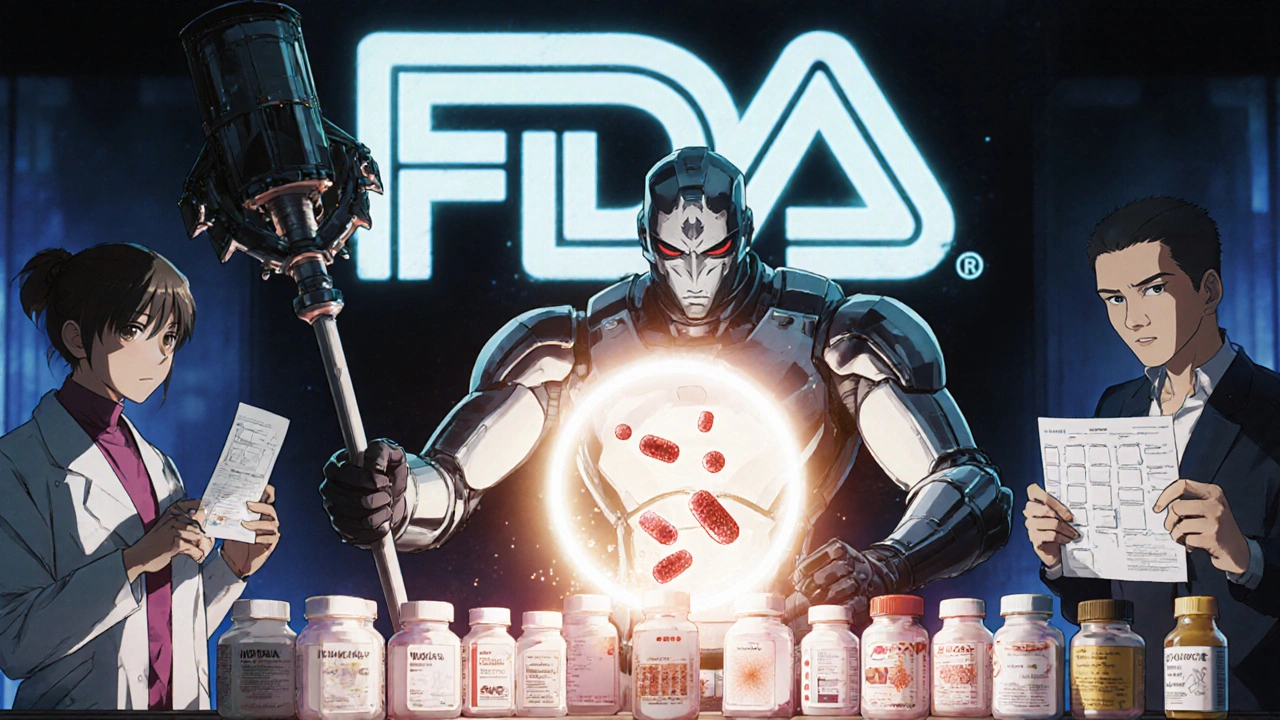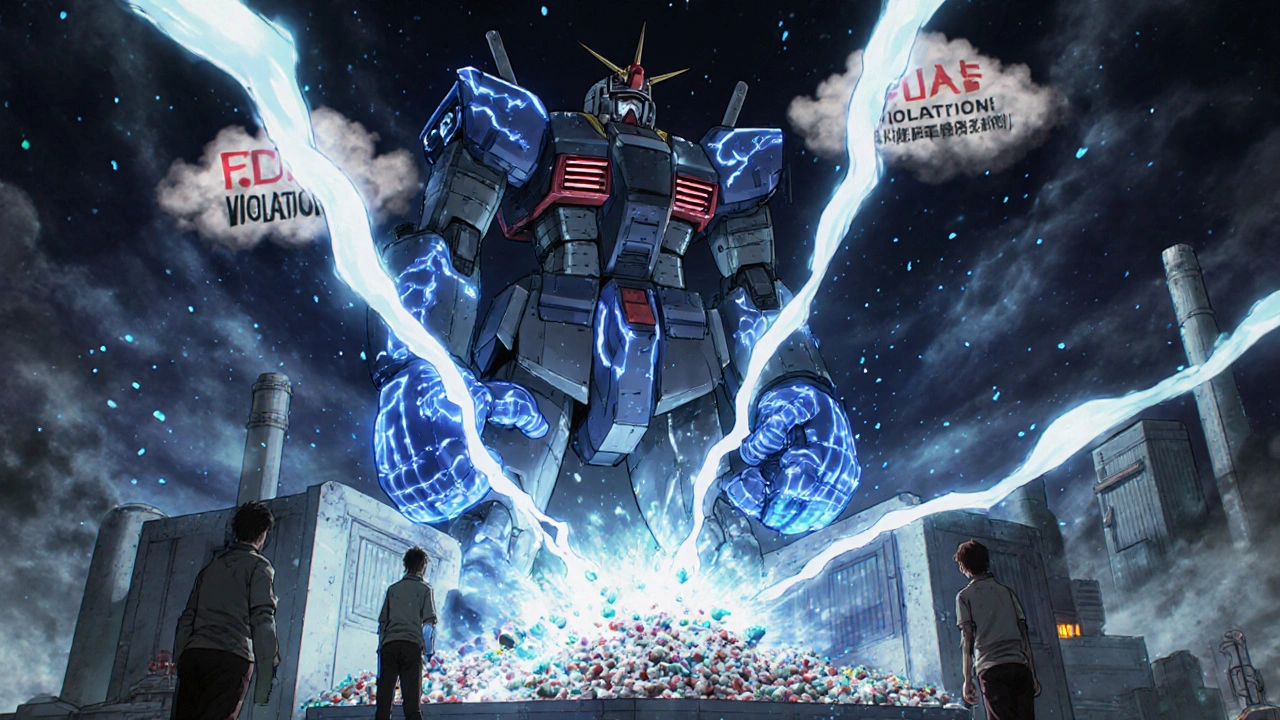Every time you pick up a generic pill, you’re trusting that it’s safe. But what if that pill contains something it shouldn’t? Between 2020 and 2022, over 1,200 reports of potential contamination in generic drugs were filed with the FDA. Some of these led to serious health problems-skin rashes, infections, even organ damage. And it’s not rare. In 2022, generic drugs made up 37% of all drug recalls linked to contamination, even though they account for 90% of prescriptions filled in the U.S.
What Exactly Is Generic Drug Contamination?
Contamination means unwanted substances end up in your medicine. This could be chemical residues from previous batches, microscopic particles from workers’ skin or clothing, bacteria, mold, or even toxic impurities like nitrosamines. The FDA defines it as the “undesired introduction of impurities” during manufacturing. These aren’t just minor flaws-they can change how a drug works or make it dangerous. For example, a patient in 2021 developed severe dermatitis after using a generic hydrocortisone cream contaminated with an unknown chemical. Another case on Reddit showed blue specks in metronidazole tablets that later tested positive for copper. These aren’t isolated incidents. They’re symptoms of deeper problems in how these drugs are made.Why Are Generic Drugs More at Risk?
All drugs-brand and generic-must meet the same FDA standards. But the system that makes generics cheaper also makes them more vulnerable. Most active ingredients (80%) come from just two countries: India and China. The FDA inspects only about 1% of imported drug products each year. Meanwhile, generic manufacturers often operate on profit margins of 20-25%, compared to 60-70% for brand-name companies. That gap affects investment in clean facilities, modern equipment, and staff training. Inspection data shows generic facilities had 8.3% of their inspections flag contamination control issues in 2022-nearly double the 5.1% rate for brand-name makers. Indian facilities had over twice the contamination-related observations as U.S.-based ones. Older factories, built before 2000, have a 34% higher risk of contamination simply because their designs don’t meet today’s standards.How Contamination Happens: The Real-World Pathways
It’s not just about dirty rooms. Contamination happens in predictable, preventable ways:- Cross-contamination: Residue from one drug gets onto another during production. This is especially dangerous with potent drugs like cancer treatments, where even tiny amounts can harm patients.
- Personnel: Workers shed 40,000 skin cells per minute. Each person generates 100,000 particles larger than 0.3 microns just by standing still. That’s why cleanrooms require full-body gowns, masks, and strict entry protocols.
- Equipment and procedures: Piercing vial stoppers with needles causes contamination in 62% of hazardous drug incidents. Breaking glass ampules? That’s 28% of cases. Even the way a technician opens a bottle matters.
- Dirty cleaning: Manufacturers must prove they remove 10 parts per million (ppm) of previous drug residue. But for some high-potency drugs, that limit is too high. One expert called it “insufficient.”

What’s Being Done to Prevent It?
The good news: prevention works when it’s done right.- Closed manufacturing systems: Teva’s facility in Italy cut cross-contamination by 78% by sealing production lines so nothing enters or escapes. These systems cost $500,000 to $2 million per line, but they’re worth it.
- Rapid testing: Instead of waiting 7 days for lab results, top manufacturers now use tech that detects microbes in 4 hours. By 2022, 63% of leading generic makers had adopted this.
- Real-time monitoring: Mylan’s Morgantown plant installed sensors that track air particles and humidity in real time. Contamination incidents dropped 82% in three years.
- Vertical integration: Companies that make their own active ingredients (APIs) have 22% fewer contamination incidents. Controlling the whole chain reduces handoffs-and risks.
What Happens When Contamination Is Found?
When a problem is detected, the response is urgent. Manufacturers must report it to the FDA through MedWatch. If the drug is already on shelves, a recall is required under 21 CFR Part 7. The average cost of a single recall? $18.7 million. That’s not just lost product-it’s damaged trust, legal fees, and lost market share. The FDA doesn’t just wait for reports. In 2022, they issued 483 observations (official notices of violations) to 8.3% of generic facilities. These aren’t warnings-they’re red flags. Common problems include poor cleaning validation (28% of cases), weak environmental monitoring (34%), and broken change control systems (22%). In one case, a compounding pharmacy had cyclophosphamide (a chemotherapy drug) on 85% of pharmacists’ work surfaces-even though guidelines say it shouldn’t be there. That’s how easily contamination spreads once it starts.
What Can Patients and Pharmacists Do?
You don’t have to wait for regulators to fix this. Here’s what you can do:- Check the source: Ask your pharmacist where the generic drug is made. If it’s from a facility with a history of FDA violations, consider asking for a different brand or manufacturer.
- Look for changes: If your pill looks different-new color, smell, texture, or specks-don’t take it. Report it to your pharmacist and the FDA.
- Use MedWatch: If you or someone you know has a bad reaction, file a report at fda.gov/medwatch. Even one report can trigger an investigation.
- Ask about testing: Hospital pharmacies and large chains sometimes test for contamination. Independent pharmacies often can’t afford it. If you’re in a small pharmacy, ask if they’ve ever seen suspicious generics.
The Bigger Picture: Supply Chains and Regulation
The real problem isn’t just bad factories. It’s a global system that moves too fast and is inspected too slowly. The 2018-2019 valsartan recall showed how wide the damage can be. Nitrosamine impurities hit 22 manufacturers across eight countries. Over 2,300 products were pulled. Costs exceeded $1.2 billion. And it took months for regulators to catch it. The National Academy of Sciences warned in 2020 that current rules don’t fully address today’s supply chain risks. The FDA’s inspection rate hasn’t kept up with the number of facilities. And while the U.S. has strong standards, many foreign plants don’t follow them consistently. Some experts argue we need product-specific contamination limits-not one-size-fits-all rules. A drug used for heart disease might need stricter controls than one for mild allergies. Right now, the system doesn’t make that distinction.What’s Next?
The future is better-but not automatic. By 2027, industry analysts predict contamination-related recalls will drop by 40% thanks to AI, rapid testing, and stricter import screening. But supply chains will stay complex. Cheaper drugs will always be tempting for manufacturers to cut corners. The best defense? Awareness. Transparency. Accountability. Patients need to know their meds aren’t guaranteed safe just because they’re cheap. Pharmacists need tools to verify quality. Regulators need more funding and better tech. And manufacturers? They need to choose safety over savings. Generic drugs saved the U.S. healthcare system over $300 billion in 2022. That’s huge. But if we lose trust in their safety, the cost will be far higher than any pill’s price tag.Can generic drugs be as safe as brand-name drugs?
Yes, they can-and often are. The FDA requires generics to have the same active ingredient, strength, dosage form, and performance as the brand version. But safety depends on manufacturing quality. While the drug itself is identical, contamination risks vary by facility. A well-run generic plant can be safer than a poorly managed brand-name one. The key is not the label-it’s the factory.
How do I know if my generic drug is contaminated?
You usually can’t tell by looking. But signs include unusual color, odor, texture, or particles in the pill. If your medication suddenly stops working or causes new side effects-like skin rashes, nausea, or infections-you should stop taking it and contact your pharmacist or doctor. Report it to the FDA through MedWatch. Don’t wait for others to notice-it might be the first report that triggers an investigation.
Are all generic drugs made overseas?
No, but most active ingredients are. About 80% of the key chemicals in U.S. drugs come from India and China. The final pills may be packaged in the U.S., but the core ingredient often isn’t. Some U.S.-based companies still make generics, but they’re fewer and often more expensive. The global supply chain is the norm, not the exception.
What should I do if I suspect contamination?
Stop taking the medication. Keep the bottle and any packaging. Contact your pharmacist and ask if they’ve seen similar issues. Then file a report with the FDA at fda.gov/medwatch. Even if you’re not sure, your report helps regulators track patterns. Don’t assume it’s just you-contamination often affects batches, not just one person.
Are there safer generic brands I can ask for?
Some manufacturers have better track records. Teva, Mylan, and Sandoz have invested heavily in clean manufacturing and have fewer FDA violations. But there’s no public list of “safe” generics. Ask your pharmacist if they know the manufacturer’s history. Some pharmacies track which suppliers have had recalls or inspections. You can also check the FDA’s website for inspection reports on specific facilities.
Why doesn’t the FDA test every batch of generic drugs?
It’s not feasible. The FDA inspects only about 1% of imported drug products each year. With over 1,000 generic manufacturers worldwide and millions of batches shipped annually, full testing would require thousands more inspectors and billions in funding. Instead, the FDA relies on facility inspections, historical data, and risk-based targeting. New tools like AI and rapid testing are helping, but the system is still stretched thin.
Can I test my own medication for contamination?
Not reliably at home. Detecting chemical or microbial contamination requires lab equipment like chromatographs or culture incubators. Independent testing labs exist, but they’re expensive and not practical for individual consumers. The best action is reporting concerns to your pharmacist or the FDA. They have the authority and tools to investigate.

Deirdre Wilson
November 26, 2025 AT 03:07My grandma’s blood pressure med had blue specks last month. She didn’t say anything ‘cause she didn’t want to be a hassle. Turned out it was copper. She got dizzy for a week. Don’t assume it’s just you - if it looks weird, it probably is.